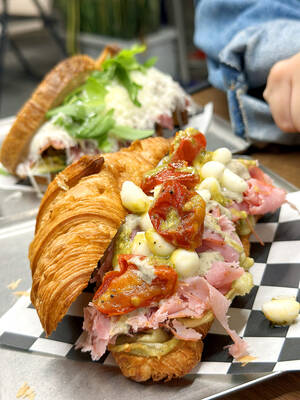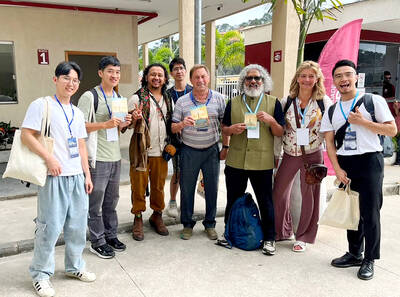Pho is a French word? Who knew?
One of the most popular dishes from Vietnam to make it to restaurant tables around the world, from New York to London, is pho. There’s pho bo and pho ga and pho tai and more.
And while the jury’s still out, it is widely believed by linguists and word sleuths that the word pho is not a Vietnamese word, but in fact comes from the French term pot au feu (pronounced ‘‘poh oh fuh’’). The word was likely introduced to Vietnam by French colonialists more than 100 years ago, according to longtime Vietnam resident Didier Corlou, a top French chef in Hanoi. Corlou told a food seminar in Hanoi in 2003 that pho most likely was a transliteration of the French term for hot pot.
The list of French “loans words” still used in Vietnam today is gaining recognition as young Vietnamese become more curious about their nation’s past, 23-year-old Abby Nguyen of Ho Chi Minh City told the Taipei Times in a recent e-mail exchange.
Before the Americans got involved in a long and protracted war in Vietnam in the 1960s and 1970s, the French had been heavily involved in the country for more than 300 years, she said. From 1853 to 1954, Vietnam was a French colony. As a result, Vietnam’s colonial past has left an indelible mark on the country’s language.
The Vietnamese word for cheese, for example, pho mat, comes from the French word fromage — say it out loud slowly — and cake is called ga to, from the French word gateau.
The word for butter — bo — comes from the French word buerre.
During a recent research expedition via keyboard and the Internet, this reporter came across more than two-dozen “loan words” from French still used in Vietnam today, in addition to pho mat and ga to and bo.
To understand all this, it helps to know a little French, but even if you never studied French in high school or college and you don’t know bonjour from bonsoir, “amusez-vous bien.” That means: “Enjoy!”
Liver pate is called pa in Vietnam today. Pate chaud, according to Californian foodie Andrea Nguyen of the Viet World Kitchen blog, is called pa so.
There’s more, according to sources in Vietnam and overseas. Ba — father in Vietnamese — comes from the French word papa, many linguists believe.
Va li comes from the French word for suitcase — valise.
Bia comes from the French word for beer, biere.
A doll is called a bup-be in Vietnam, from the French word poupee.
What to call the necktie on that senior civil servant giving a press conference on Hanoi television? It’s a ca vat — from the French word cravate.
Doc to comes from the French word docteur, which is not far from the English word doctor.
Phac to comes from facteur, the French word for mailman.
Phim means “movie” and comes from the French word film.
A pha is a headlight on a car or motorscooter, from the French word phare.
Motorscooters and motorcycles are themselves are called moto — from the French term motocyclette.
If you make a mistake in France, it is called a faute. In Vietnam today, people often say phot for mistake.
Bit-tet is from the French term biftek — beefsteak, or just plain steak.
Coffee is called ca phe, from the French word cafe.
Wine is called vang (vin).
Soap is called xa bong (savon).
A circus is called xiec (from the French word cirque).
Ben Zimmer, a noted US-based word maven who writes the weekly “On Language” column for the New York Times, pointed this reporter to the work of Milton Barber, whose 1963 paper, The Phonological Adaptation of French Loan Words in Vietnamese, was eye-opening, to say the least.
MaryJo Pham, a senior at Tufts University in Boston who was born in Vietnam and came to the US as a young girl, said she has been informally collecting French loan words used in Vietnam over the years.
“Piscine is still in use for ‘swimming pool,’” she said in an e-mail.
“And cyclo, or ‘xich lo’ in Vietnamese, is what we call a bicycle-drawn rickshaw.”
“Yogurt — yaourt in French — is called da ua in Vietnamese. Ice cream is called ca rem from the French word creme.”
A clothes zipper is called a phec mo tua in Vietnamese, from the French word fermeture, Pham said. A woman’s bra is called su chien from the French word soutien, she added.
“You can see how some French loan words influenced the actual transliteration of words — for motorscooters, women’s bras, coffee, frozen yogurt, baguette sandwiches — things that were and are indispensable to daily life in Vietnam,” Pham said. “‘Bo for butter, from the French buerre, is still definitely in use in Vietnam. And phim for movies, film, cinema, yes.”

This month the government ordered a one-year block of Xiaohongshu (小紅書) or Rednote, a Chinese social media platform with more than 3 million users in Taiwan. The government pointed to widespread fraud activity on the platform, along with cybersecurity failures. Officials said that they had reached out to the company and asked it to change. However, they received no response. The pro-China parties, the Chinese Nationalist Party (KMT) and Taiwan People’s Party (TPP), immediately swung into action, denouncing the ban as an attack on free speech. This “free speech” claim was then echoed by the People’s Republic of China (PRC),

Exceptions to the rule are sometimes revealing. For a brief few years, there was an emerging ideological split between the Democratic Progressive Party (DPP) and Chinese Nationalist Party (KMT) that appeared to be pushing the DPP in a direction that would be considered more liberal, and the KMT more conservative. In the previous column, “The KMT-DPP’s bureaucrat-led developmental state” (Dec. 11, page 12), we examined how Taiwan’s democratic system developed, and how both the two main parties largely accepted a similar consensus on how Taiwan should be run domestically and did not split along the left-right lines more familiar in

Specialty sandwiches loaded with the contents of an entire charcuterie board, overflowing with sauces, creams and all manner of creative add-ons, is perhaps one of the biggest global food trends of this year. From London to New York, lines form down the block for mortadella, burrata, pistachio and more stuffed between slices of fresh sourdough, rye or focaccia. To try the trend in Taipei, Munchies Mafia is for sure the spot — could this be the best sandwich in town? Carlos from Spain and Sergio from Mexico opened this spot just seven months ago. The two met working in the

Many people in Taiwan first learned about universal basic income (UBI) — the idea that the government should provide regular, no-strings-attached payments to each citizen — in 2019. While seeking the Democratic nomination for the 2020 US presidential election, Andrew Yang, a politician of Taiwanese descent, said that, if elected, he’d institute a UBI of US$1,000 per month to “get the economic boot off of people’s throats, allowing them to lift their heads up, breathe, and get excited for the future.” His campaign petered out, but the concept of UBI hasn’t gone away. Throughout the industrialized world, there are fears that